In this post, learn, that what is an electrical relay, and how it works. What are “NO” and “NC” contacts in the relay, and the applications of the electrical relay?
The contents of the article are as follows
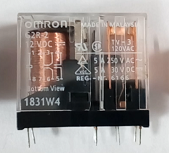
What is a relay
A relay is an electrically operated switch. The relay connects two or more electrically isolated circuits. The relay requires an input electrical signal to operate its switch contacts. Still, both circuits can remain isolated.
An electromechanical relay is an electro-mechanical type switch. It is an electromechanical type relay as it has an armature mechanical movement controlled by an electrical signal.
The electromechanical relay consists of a magnetic coil. It also has an electrical contact on an armature (iron-type rod) with a spring attached. When an electric current flows through the coil, then the iron core of the coil becomes magnetized. This magnet attracts the armature (iron rod), which has many contact points mounted on it.
In this way, the normally open contact becomes ON. and normally closed contacts become OFF. Now if we remove the supply in the coil, then contacts return to the original position.
If the current in the coil becomes zero, then the spring brings back the armature to the original position.
Thus a low-rating switch contact of a relay can control the high-rating switch or electrical contactor.
The devices similar to the relay also come in high contact current ratings, but they are called contactors.
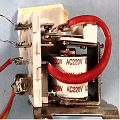
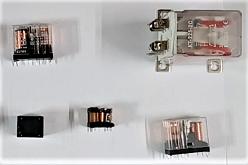
What are the NO and NC contacts?
Electrical relays have some electric contacts. These contacts act like a switch. Contacts can be of normally open (NO) type or normally closed (NC) type. The contacts of the relay operate when the coil operates. These contacts are useful to make or break an electrical circuit.
The NO (normally open) contact in a relay is the contact that remains open when the power is off. As soon as the power turns on, this contact becomes closed.
The second type of contact NC (normally close) is the contact, which remains closed in case of power failure. As soon as the power turns on, this contact becomes open.
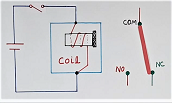
Further, these relays can have multiple contacts depending on the requirements. These contacts are designed for the high currents required by electrical circuits.
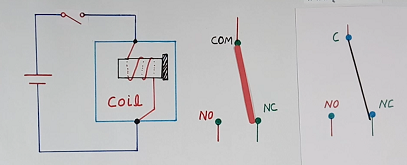
Here you see only 2 NO NC contacts. But many devices may have many NO NC contacts.
Testing NO and NC contact in a relay for learning (DIY)
Refer figure given below. In the circuit, one red LED connects NO and Common point with a resistor and 9 Volts battery. A green LED connects NC contact with common using a 1K resistor and battery.
The battery is 9V and the relay coil rating is 9V DC. You can take any other suitable coil rating.
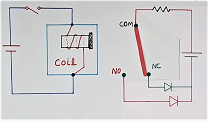
When the relay is off, Then NC contact will close, and the green LED will glow. If we energize the coil with a battery and with a switch as per the figure, then NO contacts get connected to common (COM) contact. Now the red LED will glow.
Now if we remove the supply from the coil with the switch in the OFF position, the Contact NC connects to the COM again, and the green LED will glow again.
Rating of a relay
The electrical relays have two types of ratings. One rating defines the rating of an electrical coil. Another rating defines the rating of electrical contact.
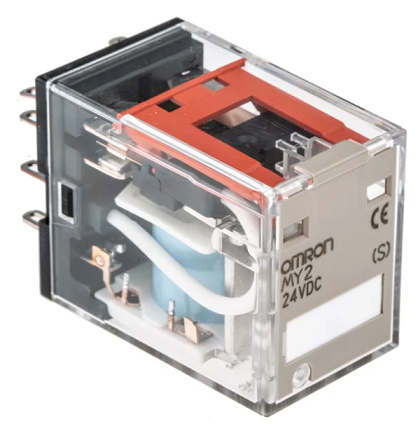
The coil of the electromechanical relay can be of both AC and DC types. These are available in different voltages. Coil voltage can be 6 Volt DC, 12 Volt DC, 24 Volt DC, or 220 Volt AC. Fig 1 Omran relay. The rating of the coil is 24V DC. The rating of the contact is 10A.
Further another example, Jyothi made DC Voltage operated Auxiliary Relay RE-300, Contact rating is 10 amp at 250V AC. It has a coil rating of 24 volts DC.
Another key point is that it may have many normally open and normally closed contacts. Not only the many contacts can operate many types of equipment at a time. Many contacts also help to simplify logic sequence requirements.
The contacts rating may be selected as per requirement. You must select coil rating and contact rating separately. The current rating of contact rating will be more. The coil current rating will be less.
The problem of low voltage in the coil
If the voltage is low in the relay coil, then there may be problems. It may not become ON. Or, It may become ON OFF many times. So contacts will be becoming ON OFF continuously. We call it chattering. Then contacts may damage, and load equipment also may damage.
Applications of the relay
Electric relays can be used to increase the current rating of a switch. First, the switch controls the coil with a small current. Then the contacts of the relays can control or switch a more current of the load.
Further another application of the electrical relays is for electrical isolation or for creating any logic.
They also find applications in as switch rating amplifiers, equipment ON OFF, emergency off, indication, sequence logic, safety, noise filter, voltage shifting, switch off logic, etc.
As a matter of fact, big projects have a lot of equipment. So, they have to be turned ON and OFF in the sequence. At that time relays perform the sequence logic.
The sequence logic of large equipment requires a large number of relays. Many of them will have many normally open and normally closed contacts.
In fact, I designed many control system panels for many very big projects like HVDC, SVC, etc with electronic PCBs. And I used a few relays in almost all the panels.
Further, Typical applications of the relay are as follows:
- Switch rating amplification
- Equipment & devices ON-OFF
- Emergency OFF
- Sequence logic
- Electrical switch isolation
- Safety
- Noise filter
- Voltage shifting
- Switch off logic
- Protection
- Power off sensor
- Remote switch sensing
- Control logic
- Switch multiplication
- Indications
- Door lock with power ON logic in high voltage area rooms.
- Change over switch like in UPS
- Hold ON circuits
To gain more knowledge, watch the video to see further its operation, experiments, and practicals. Watching this video will help you understand better and more easily.
Read further about what is an optocoupler
Further, you can read this in Hindi, Relay kya hai.
Keep learning about the voltage of neutral wire with respect to earth.
Also, read Why power factor correction in AC supply?
Further, read AC or DC which is more dangerous
I hope that you enjoyed reading the article What is an electrical relay?
If so, then subscribe to my YouTube channel.
About the author – G K Agrawal B.Sc and B.Tech (from HBTU Kanpur), Retd. Sr DGM Design (BHEL), the inventor of patents, has lifelong industry experience in the electrical and electronics design field of R&D. He worked for BHEL. He shares his experience and knowledge on blogs and YouTube. Read the profile here.



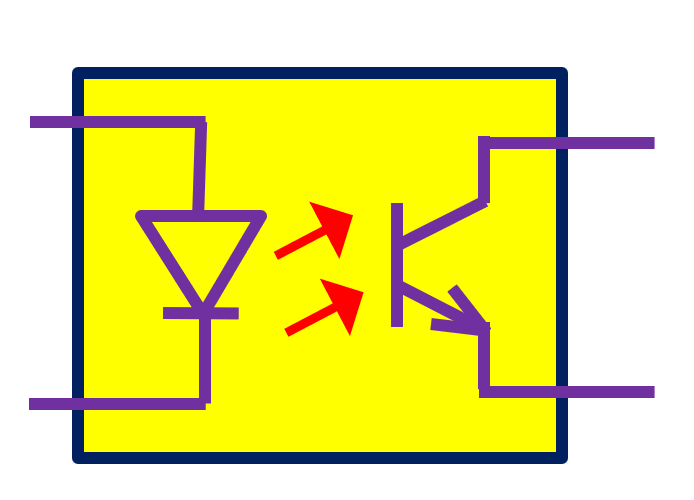
Good experience
Букмекерская контора 1xBet является очень популярных на рынке. https://bet-promokod.ru/ Большой выбор событий из мира спорта и киберспорта, множество открытых линий, самые высокие коэффициенты. Кроме того, БК имеет обширный функционал и немногие дает возможность совершать ставки по уникальным промокодам. Используя их, вы можете получить реальный денежный выигрыш, не внося абсолютно никаких средств. Это реально! Узнать актуальный промокод вы можете сейчас же, однако использовать его необходимо в соответствии с правилами и инструкциями, которые приведены ниже.
I haven¦t checked in here for a while because I thought it was getting boring, but the last few posts are good quality so I guess I will add you back to my everyday bloglist. You deserve it my friend 🙂